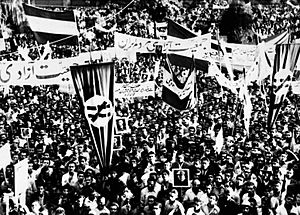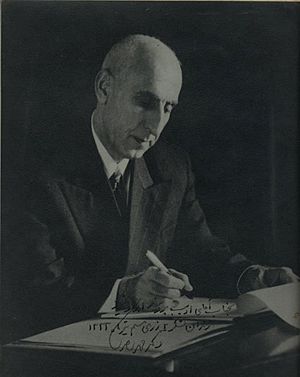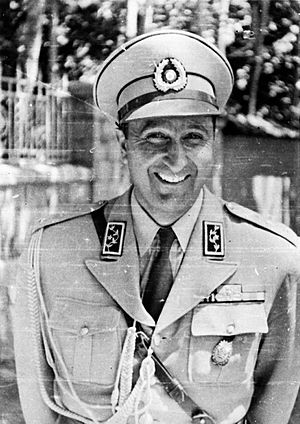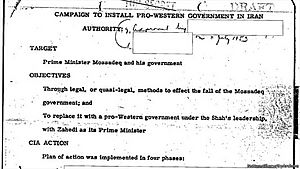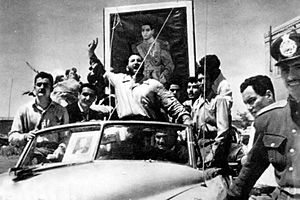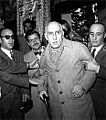1953 Iranian coup d'état facts for kids
Quick facts for kids 1953 Iranian coup d'état |
|||||||
|---|---|---|---|---|---|---|---|
| Part of the Abadan Crisis, and the Cold War | |||||||
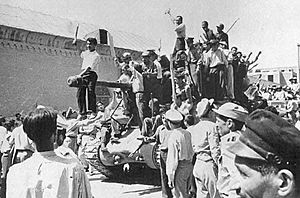 Coup supporters celebrate victory in Tehran |
|||||||
|
|||||||
| Government-Insurgents | |||||||
| Commanders and leaders | |||||||
| Units involved | |||||||
| Casualties and losses | |||||||
| 200–300 killed | |||||||
The 1953 Iranian coup d'état was a major event in Iran's history. It was a secret plan by the United States and the United Kingdom to remove Iran's democratically elected Prime Minister, Mohammad Mosaddegh. This happened on August 19, 1953. The goal was to make the shah (king) of Iran, Mohammad Reza Pahlavi, more powerful. The U.S. called its part "Operation Ajax," and the UK called its part "Operation Boot."
Mosaddegh wanted to check the finances of the Anglo-Iranian Oil Company (AIOC). This was a British company that controlled Iran's oil. He wanted to make sure Iran was getting its fair share of money. When the company refused, Iran's parliament decided to take control of the oil industry. This is called nationalizing it. Britain then stopped buying Iranian oil to hurt Iran's economy.
The British and later the U.S. worried about Mosaddegh. They feared he was too close to communist groups. So, they decided to remove him from power. After the coup, General Fazlollah Zahedi became the new prime minister. The Shah's power grew, and he relied on U.S. support. Between 200 and 300 people died during the conflict. Mosaddegh was arrested and spent the rest of his life under house arrest. The Shah ruled for 26 more years until the Iranian Revolution in 1979.
In 2013, the U.S. government officially admitted its role in the coup. They released documents showing they planned and carried out the operation. This included paying Iranian politicians and spreading propaganda.
Contents
Iran's Past: Foreign Influence
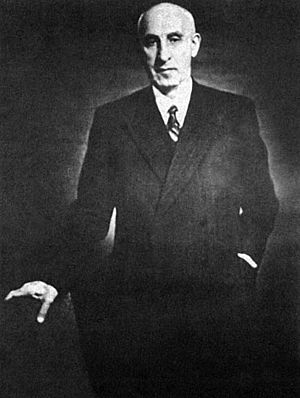
For a long time, Iran was caught between the powerful Russian and British empires. These countries often tried to control Iran's resources and politics. In the late 1800s, Iran's kings often gave special rights, called "concessions," to foreign companies. These deals allowed foreigners to control things like roads, telegraphs, or valuable resources.
One important concession was for oil. In 1901, a British man named William Knox D'Arcy got the right to search for oil in Iran. He found oil in 1908. Later, the British government bought a large part of this company. It became the Anglo-Persian Oil Company (APOC). This meant Britain controlled most of Iran's oil.
Iran's Fight for Democracy
The British often interfered in Iran's internal affairs. This made many Iranians angry. In 1906, protests forced the king to accept a new constitution. This constitution created a parliament (a group of elected lawmakers) and a prime minister. It limited the king's power. However, the king still had some important powers, which caused problems later.
After World War I, many Iranians were unhappy with the oil deal. They felt Iran was not getting enough money from its own oil. In 1921, a general named Reza Khan came to power. He became prime minister and then, in 1925, became the new Shah, starting the Pahlavi Dynasty. Reza Shah worked to modernize Iran very quickly. But he was also a harsh ruler and did not allow people to disagree with him. He jailed opponents, including Mohammad Mosaddegh. This made Mosaddegh dislike kings who had too much power.
In 1941, during World War II, British and Soviet forces invaded Iran. They removed Reza Shah from power. His young son, Mohammad Reza Pahlavi, became the new Shah. The Allies thought he would be easier to control. The new Shah was not as strong as his father. This allowed Iran's democracy to grow again for a while.
After the war, the British left, but the Soviet Union tried to keep some control. The U.S. helped Iran get rid of Soviet influence. Iranian leaders then wanted to reduce all foreign control, especially over their oil. The British-controlled AIOC refused to show its financial records. This made Iranians even more upset.
Oil Nationalization: Iran Takes Control
Many Iranians felt the British oil company was taking advantage of their country. They saw it as a symbol of British control.
Mosaddegh Becomes Prime Minister
In 1949, the Shah's power grew after an assassination attempt on him. He changed the constitution to give himself more authority. Mosaddegh and other political parties formed a group called the National Front. Their main goal was to nationalize Iran's oil.
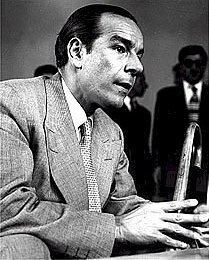
By 1951, the National Front won many seats in parliament. The Prime Minister, who was against nationalizing oil, was killed. Mosaddegh was then appointed Prime Minister by the Shah. Mosaddegh believed the Shah should "reign, but not rule," like kings in Europe. He wanted the elected government to have more power than the unelected Shah.
The Shah and Mosaddegh did not get along. Mosaddegh used his popularity and the support for oil nationalization to limit the Shah's power. The Shah was angry but could not act against Mosaddegh because he was so popular. In 1952, the Shah tried to fire Mosaddegh, but huge protests forced the Shah to bring him back.
The Abadan Oil Crisis
In late 1951, Iran's parliament voted to nationalize the oil industry. This decision was very popular and made Mosaddegh a national hero. Iranians felt they were finally taking control of their own country. They hoped it would bring great wealth.
Britain was very unhappy. They refused to negotiate with Mosaddegh. Mosaddegh offered to split oil profits 50/50, like Venezuela did with American companies. But Britain refused. Instead, they started planning to weaken Mosaddegh's government.
Britain stopped buying Iranian oil. They also blocked Iran's ports with their navy. This was called the Abadan Crisis. Iran's economy suffered greatly. Thousands of people lost their jobs at the oil refinery. British agents in Tehran also tried to secretly undermine Mosaddegh's government.
Britain took Iran to the International Court of Justice, but the court said it had no power over the case. Still, Britain continued its oil embargo.
Growing Problems for Mosaddegh
By mid-1952, the British oil embargo was hurting Iran badly. Mosaddegh's political support started to weaken. A religious leader who had supported Mosaddegh, Abol-Ghasem Kashani, turned against him. This was because Mosaddegh was reducing Kashani's power.
British agents tried to influence elections by bribing people. They hoped to get lawmakers who would vote to remove Mosaddegh.
The Communist Tudeh Party also became active. They started to support Mosaddegh, but secretly hoped to bring communism to Iran. They organized protests and sometimes caused violence. This made many people, especially in the U.S., fear a communist takeover in Iran.
The U.S. was busy with the Korean War. President Harry S. Truman did not want to overthrow Mosaddegh. But in 1953, Dwight D. Eisenhower became president. The UK convinced the U.S. that Iran was in danger of falling to the Soviets. So, the U.S. agreed to a joint plan to remove Mosaddegh.
Mosaddegh's Final Months
By 1953, the British embargo and political problems hurt Mosaddegh's popularity. He was blamed for the economic crisis. Street fights between different political groups became common. Mosaddegh began to use emergency powers, which made some of his supporters worried he was becoming a dictator. He jailed political opponents.
The Tudeh Party's unofficial alliance with Mosaddegh increased fears of communism. The Shah himself did not want a coup at first. But the CIA told him he would be removed if he did not cooperate. Mosaddegh's decision to dissolve parliament also helped convince the Shah.
Operation Ajax: The Coup Begins
The official reason for the coup was Mosaddegh's decision to dissolve parliament. This gave him and his cabinet full power. The Shah finally agreed to support the CIA's plan.
The CIA prepared royal decrees, signed by the Shah, to fire Mosaddegh and appoint General Fazlollah Zahedi as the new prime minister. On August 15, 1953, the commander of the Imperial Guard delivered the decree to Mosaddegh. But Mosaddegh had been warned. He rejected the order and had the commander arrested. Mosaddegh argued that the Shah did not have the power to fire an elected prime minister without parliament's approval.
After this first attempt failed, the Shah and his wife fled to Baghdad and then to Italy. Mosaddegh's supporters celebrated in the streets. Mosaddegh believed he had won and told his supporters to go home.
General Zahedi, who was hiding, met with supporters of the Shah. They quickly made a new plan using money from the CIA. They used the fear of communism and the Shah's flight to gain support.
On August 19, people hired by the CIA, pretending to be Tudeh Party members, started a "communist revolution." They encouraged real Tudeh members to join. These groups attacked businesses and destroyed shops in Tehran. This caused many ordinary Iranians to be terrified of a communist takeover.
Then, a second group of paid people, pretending to be Shah supporters, organized angry crowds. These crowds were upset about the violence and the "communist revolution." They fought back against the Tudeh Party members. The army then left its barracks and took control of government buildings. Mosaddegh fled his house but later surrendered. By the end of the day, General Zahedi and the army controlled the government.
The Shah returned to Iran. He was greeted by cheering crowds. Mosaddegh was arrested, tried, and sentenced to three years in prison, followed by house arrest for life. Other Mosaddegh supporters were jailed or executed.
The United States' Role in the Coup
After the coup, the U.S. made sure that the British oil company no longer had full control. Five American oil companies, along with British and French companies, shared Iran's oil. The Shah said this was a victory for Iran. Oil money increased greatly, helping Iran's economy.
The CIA played a big part in the coup. Senior CIA officer Kermit Roosevelt Jr. led the operation. Another agent, Donald Wilber, planned it. They bribed Iranian officials, reporters, and business people. They also paid street gangs to support the Shah and oppose Mosaddegh.
One tactic was to pay people to pretend to be anti-Shah. These agents would attack symbols of the Shah while shouting pro-Mosaddegh slogans. The CIA believed this would make average Iranians dislike Mosaddegh.
The British and American spy agencies helped the Shah stay in power for 26 years. This ensured Western control over Iran's oil. Some Iranian religious leaders also helped the Western spy agencies. They were unhappy with Mosaddegh's non-religious government.
In 2013, the U.S. government released documents confirming its role in the coup. These documents showed the U.S. planned and carried out the coup. They also showed that the UK had asked the U.S. to join the coup in 1952.
Why Did the U.S. Get Involved?
Historians have different ideas about why the U.S. decided to help with the coup.
- Oil Control: Some historians believe the main reason was to gain control over Iran's oil. If Mosaddegh had fully nationalized the oil, other countries might have done the same. This would have hurt U.S. oil interests worldwide.
- Fear of Communism: Many believe the U.S. was mainly afraid of a communist takeover in Iran. The Cold War was happening, and the U.S. saw the Soviet Union as a threat. They worried that the Tudeh Party, which was communist, would gain power. Even though there was not strong proof of a communist takeover, U.S. officials were very concerned.
- Supporting Allies: The U.S. also wanted to keep its close relationship with Britain. Britain was a key ally in the Cold War. Helping Britain with Iran was important to the U.S.
The Role of Religious Leaders
Mosaddegh appointed non-religious ministers to his government. This made him lose support from some religious leaders. In 1953, Abol-Ghasem Kashani and his followers protested against Mosaddegh's liberal ideas. They were against things like giving women the right to vote.
Some religious leaders, like Mohammad Behbahani, helped organize protests against Mosaddegh. They hoped that removing Mosaddegh would lead to a more religious government. There are reports that some religious leaders received money from the CIA. The opposition from religious leaders was a key reason for Mosaddegh's downfall.
What Happened After the Coup?
The coup had a huge and lasting impact on Iran and its relationship with the U.S.
Impact on the U.S. and Iran
The coup damaged the U.S.'s reputation in Iran. In 2000, U.S. Secretary of State Madeleine Albright said the U.S. intervention was a setback for Iran's democracy. Many believe the coup greatly contributed to the Iranian Revolution in 1979. This revolution removed the Shah and created an anti-Western Islamic republic.
United States Supreme Court Justice William O. Douglas said that when Mosaddegh tried to make reforms, the U.S. and Britain worked together to destroy him. He noted that because of this, the U.S. was no longer respected in the Middle East.
Changes in Iran
When the Shah returned, he was welcomed by crowds. He felt he had the people's support. However, he was never able to shake off the idea that he was a "foreign imposed" ruler. The coup also made him respect American power but dislike the British.
The Shah's government cracked down on all political opposition. The National Front was outlawed, and many of its leaders were arrested. The Communist Tudeh Party faced the harshest crackdown. Thousands of its members were arrested. Many were executed or jailed for life.
Secret Police (SAVAK)
After the coup, the Shah created a secret police force called SAVAK. Many of its agents were trained by the U.S. SAVAK watched people who disagreed with the government and censored information. Hundreds of people were executed for political reasons during the Shah's rule.
Oil and Economy
The British oil embargo ended after the coup. Iran's oil income increased a lot. The Shah agreed to a new deal where a group of British, European, and American oil companies controlled Iran's oil. This brought a lot of money into Iran. The U.S. also sent aid and advisors. Iran started to develop quickly under the Shah. By the 1970s, Iran was becoming very wealthy.
However, when the Shah tried to control oil prices again in the 1970s, U.S. support for him decreased. This ironically sped up his downfall.
The CIA later admitted that the coup turned Iran from a constitutional monarchy into a more absolute kingship. This led to many unexpected problems, with the 1979 Iranian Revolution being the biggest one.
International Impact
The 1953 coup was the first time the U.S. used the CIA to overthrow a democratically elected government. The Eisenhower administration saw it as a success. It made covert actions (secret operations) a key part of U.S. foreign policy. Another similar coup happened in Guatemala the next year.
A pro-American government in Iran gave the U.S. a strategic advantage in the Middle East.
In 2009, U.S. President Barack Obama spoke about the U.S. role in the 1953 coup. He said that the U.S. played a part in overthrowing a democratically elected Iranian government. He said it was important to move forward from the past.
Legacy of the Coup
In Iran today, the memory of the coup is very different from how it's seen in Western history books. Some Iranian leaders believe that Mosaddegh failed because he did not pay enough attention to religious figures. They also say he trusted the U.S. too much.
Mosaddegh remains a popular figure among Iranian opposition groups. His image is a symbol for those who want democracy and no foreign interference.
Images for kids
-
Hossein Fatemi after arrest
-
Mohammad Mosaddegh in court, November 8, 1953.
See also
 In Spanish: Golpe de Estado en Irán de 1953 para niños
In Spanish: Golpe de Estado en Irán de 1953 para niños


